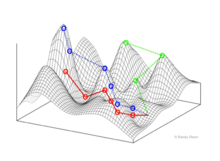
Imagine if we were to run a project to determine the optimal point of leverage for an investment portfolio. If an investor employs too low a leverage, he will extract too small a gain in the stock-market. If the leverage is set too high, then the investor can be wiped out in the next downturn.
The fitness of an investment strategy can thus form a Mount Fuji like shape. As leverage goes up, the fitness of the portfolio hits a peak and then drops thereafter.
In practice no one really knows what the ideal leverage multiplier is. Warren Buffett was theorized to have it at around 1.7. My personal rate is between 1.3 and 1.5. Making matters worse, we aren't really sure whether leverage has multiple peaks.
Making matters even more complicated is that the portfolios we choose as well as the market cycle will determine the optimal leverage rate. Being back to lock down investment grade bonds that produce bigger coupons than the leveraged financing rate is crucial to portfolio survival. A portfolio of growth stocks can threaten the survival of the portfolio as small swings get magnified by a large degree on a daily basis.
Leverage ultimately depends on other factors like the return and volatility. But adding more factors increase the dimensionality of the Mount Fuji graph and what we will really get even in the simplest of cases is a rugged terrain like the diagram shown above.
In such a case, finding an optimal point becomes even harder. If we take the path with the highest gradient, we might be able to locate a localized maxima but miss out on the global maxima somewhere else.
In the face of such confusion, I only have a simple rule of thumb that can help most investors.
Just keep your equity multiplier somewhere between 1 and 2.
No comments:
Post a Comment